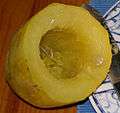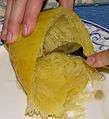Spaghetti squash
| Spaghetti squash | |
|---|---|
 Fruit of a yellow-skinned cultivar | |
| Species | Cucurbita pepo |
| Origin | North America and Central America |
| Nutritional value per 100 g (3.5 oz) | |
|---|---|
| Energy | 130 kJ (31 kcal) |
|
6.91 g | |
| Sugars | 2.76 g |
| Dietary fiber | 1.5 g |
|
0.57 g | |
|
0.64 g | |
| Vitamins | |
| Vitamin A equiv. |
(1%) 6 μg (1%) 64 μg |
| Thiamine (B1) |
(3%) 0.037 mg |
| Riboflavin (B2) |
(2%) 0.018 mg |
| Niacin (B3) |
(6%) 0.95 mg |
| Pantothenic acid (B5) |
(7%) 0.36 mg |
| Vitamin B6 |
(8%) 0.101 mg |
| Folate (B9) |
(3%) 12 μg |
| Vitamin C |
(3%) 2.1 mg |
| Vitamin E |
(1%) 0.13 mg |
| Minerals | |
| Calcium |
(2%) 23 mg |
| Iron |
(2%) 0.31 mg |
| Magnesium |
(3%) 12 mg |
| Manganese |
(6%) 0.125 mg |
| Phosphorus |
(2%) 12 mg |
| Potassium |
(2%) 108 mg |
| Zinc |
(2%) 0.19 mg |
|
| |
| |
|
Percentages are roughly approximated using US recommendations for adults. Source: USDA Nutrient Database | |
Spaghetti squash — or vegetable spaghetti — is a group of cultivars of Cucurbita pepo subsp. pepo.[1] The fruit ranges from ivory to yellow/orange in color. The orange varieties have a higher carotene content. Its center contains many large seeds. Its flesh is bright yellow or orange. When raw, the flesh is solid and similar to other raw squash; when cooked, the flesh falls away from the fruit in ribbons or strands like spaghetti.
Preparation
Spaghetti squash can be baked, boiled, steamed, and/or microwaved.[2] It can be served with or without sauce, as a substitute for pasta. The seeds can be roasted, similar to pumpkin seeds.[2]
Nutrition
Spaghetti squash contains many nutrients, including folic acid, potassium, vitamin A, and beta carotene. It is low in calories, averaging 42 calories per 1-cup (155 grams) serving.[3]
Cultivation
Spaghetti squash is relatively easy to grow, thriving in gardens or in containers.[4]
The plants are monoecious, with male and female flowers on the same plant.[5] Male flowers have long, thin stems that extend upwards from the vine. Female flowers are shorter, with a small round growth underneath the petals. This round growth turns into the squash if the flower is successfully pollinated.
Spaghetti squash plants may cross-pollinate with zucchini plants.
 Unprepared
Unprepared Cooked
Cooked Prepared
Prepared Male flower
Male flower Female flower
Female flower Being sold at a Greengrocer in Japan
Being sold at a Greengrocer in Japan
References
External links
| Wikibooks Cookbook has a recipe/module on |
- Beany, A.H., P.J. Stoffella, N. Roe, and D.H. Picha (2002). "Production, fruit quality, and nutritional value of spaghetti squash". In J. Janick; A. Whipkey. Trends in new crops and new uses. Alexandria, VA: ASHS Press. pp. 445–448.
